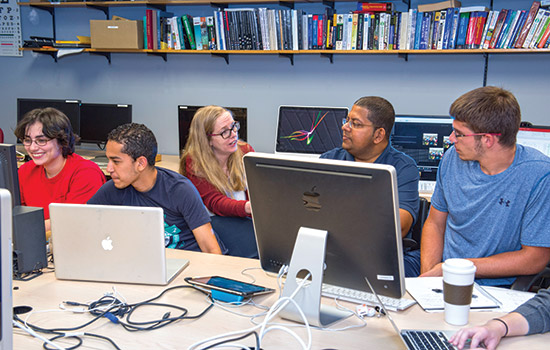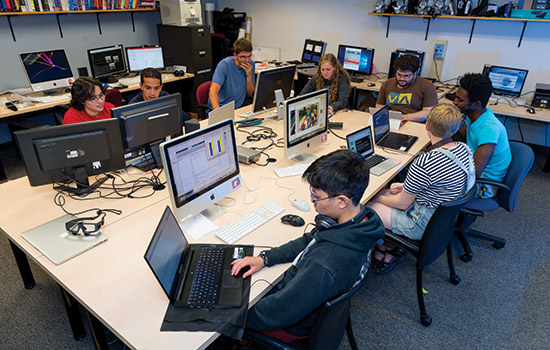Undergraduates Team up with RIT Faculty on Computational Sensing Research
Undergraduate Research: College students from across the country participated in the Research Experiences for Undergraduates program in Computational Sensing this summer. The 10-week program, funded by the National Science Foundation, involved research in sensory data such as visual-linguistic multimodal image understanding, cognition and narration, comparison of online vs. face-to-face learning, and more.
Can sensing technology reveal how readers make sense of narrated experiences in social media? What can sensing tell us about how online vs. face-to-face learning contexts influence students? Can sensory data processed with an algorithm accurately predict how a person rates a video clip? Thanks to a National Science Foundation grant, undergraduate students worked with RIT faculty to gain valuable experience in research projects such as these.
Valuable Career Preparation
For 10 weeks in the summer of 2017, 10 undergraduates from around the country participated in the Research Experiences for Undergraduates (REU) Site in Computational Sensing at RIT. Led by faculty members Cecilia Ovesdotter Alm and Reynold Bailey, the students had transformative experiences that included not only doing in-depth research but also learning skills necessary for careers in research.
REU programs exist all over the United States, with RIT leading among higher education institutions in New York state with a total of eight in 2017. The focus of other REU programs at RIT varies from organic photovoltaic devices to imaging in the physical sciences.
“The intent of these programs is to give undergraduate students experience with the research process early on in their careers,” Bailey said.
That experience helps students shape their career paths and provides a boost when it comes to applying to graduate school. “It opens up so many doors to students when they get involved with research as an undergraduate,” Bailey said. “I’m a perfect example. I went right into a Ph.D. program because I had some undergraduate research experience.”
That opportunity drew participant David Nester, who attends Eastern Mennonite University in Virginia, to apply to the REU. “This program gives good experience with high-level research and academic exposure that you can’t really get anywhere else. It helps me to prepare for grad school and professional environments that you don’t get in regular undergraduate programs.”
But the benefits go well beyond the academic leg-up. “It is exciting that students are contributing to fundamental computational sensing research in projects with numerous benefits for society,” Alm said.
Participant Nse Obot, who attends the University at Buffalo, agreed. “I really like that you get to devote yourself to research.” Obot said that he has found it hard to find time for research while juggling his academic load during the school term.
The undergraduate students teamed up with RIT faculty and Ph.D. students to conduct research on understanding human behaviors and cognitive processes using sensing technologies in several projects.
Different Backgrounds and Perspectives
Diversity is a hallmark of the REU in Computational Sensing as Alm and Bailey pointed out. The students hailed from a variety of institutions, ranging from Indiana University (about 48,000 students) to Eastern Mennonite University (about 1,200 students). “These are students from diverse backgrounds, which is incredibly important in research,” Alm said. The program attracted students from a wide number of underrepresented groups in computing.
Participant Nikita Haduong, who attends Indiana University, agreed. “I think this program is also really good for finding colleagues, not necessarily in the same field but related to it, so you get a diverse perspective.” Haduong chose this REU program because she’s interested in natural language processing.
The REU program is also interdisciplinary. Alm is on the faculty in the College of Liberal Arts, while Bailey is a faculty member in the B. Thomas Golisano College of Computing and Information Sciences. Faculty mentors and workshop facilitators also reflect the diversity and interdisciplinary nature of the program, Alm noted. The grant of approximately $360,000 supports three consecutive summers of student cohorts.
There are already success stories from the program’s first year (summer 2016). Three of the teams have published in peer-reviewed venues and one student (who has since entered a Ph.D. program) presented her research at the Council on Undergraduate Research REU Symposium at the National Science Foundation.
Along with conducting research, REU participants received valuable experiences in other areas such as learning how to write a technical paper and how to conduct a critique of peers’ work. Students gave lightning talks (short presentations) that were reviewed by faculty not only from RIT but also from Malmö University in Sweden via remote video connection. Another event offered insights into graduate school and research across REUs. Students further reached out to the community at a local library where they presented demos of sensing devices to patrons of all ages.
The REU experience culminated with the 26th Annual Undergraduate Research Symposium at RIT, at which RIT students along with students visiting in REU programs had the opportunity to present their research.
To be accepted to the REU in Computational Sensing, students underwent an application and review process by a selection committee of RIT faculty. Recruitment for summer 2018 is underway.
On the Web
Research Experiences for Undergraduates in Computational Sensing:
 Interdisciplinary: Associate professors Cecilia Ovesdotter Alm, center, from the College of Liberal Arts, Computational Linguistics and Speech Processing Lab, and Reynold Bailey from the B. Thomas Golisano College of Computing and Information Sciences, Computer Graphics and Applied Perception Lab, worked with students on interdisciplinary research projects.
Interdisciplinary: Associate professors Cecilia Ovesdotter Alm, center, from the College of Liberal Arts, Computational Linguistics and Speech Processing Lab, and Reynold Bailey from the B. Thomas Golisano College of Computing and Information Sciences, Computer Graphics and Applied Perception Lab, worked with students on interdisciplinary research projects.













